THE THEATRE ORGAN
PART TWO:
BUILDERS OF THE THEATRE ORGANS
THIS PAGE IS WRITTEN IN CONJUNCTION WITH
GLEN TWAMLEY (FRIENDS OF BEER WURLITZER)
-oOo-
PAGE TWELVE:
THE WURLITZER ORGAN CONTINUED
-oOo-
EXPORTING EUROPE’S LARGEST
WURLITZER ORGAN TO THE U.K.
-oOo-
In 1930, the Wurlitzer Organ Company built what was to be their largest Wurlitzer Theatre Organ to be exported to Europe. This Theatre Organ was to be installed at the Trocadero Super Cinema Elephant & Castle in South London.
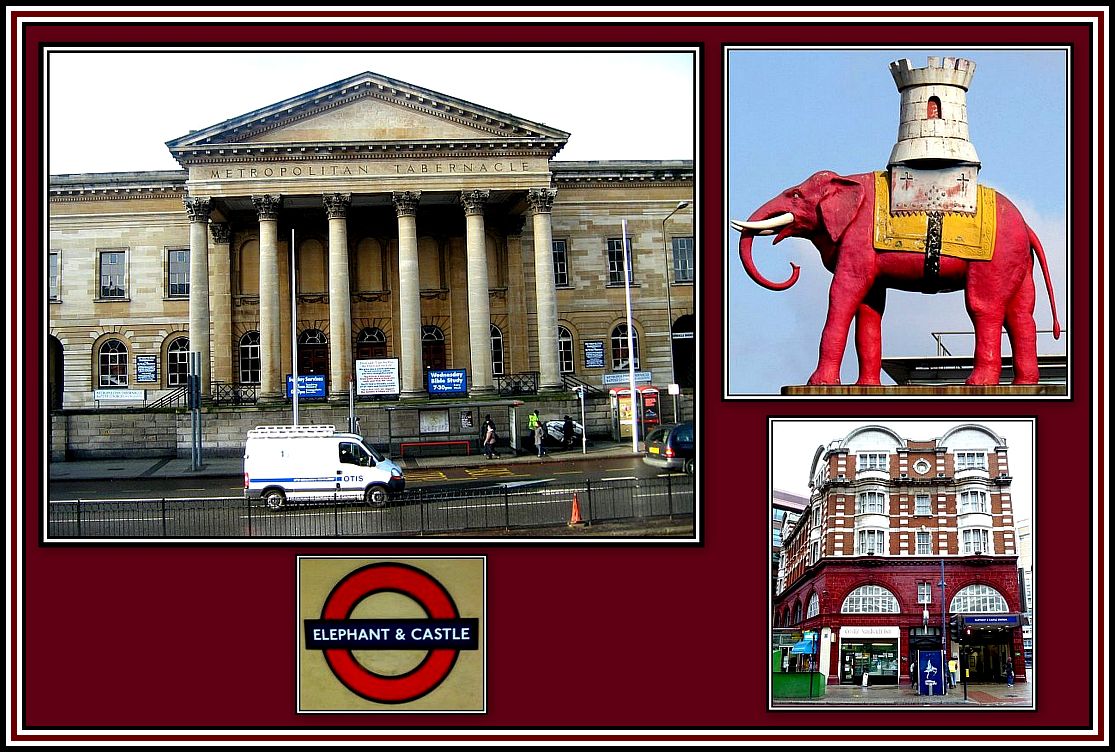
The Elephant & Castle area was known at the time, as the Piccadilly of South London and was an Entertainment Centre for both local residents and visitors from all over London. Today, the area has been blighted and is nothing more than a roundabout.
-oOo-
H & G KINEMAS
-oOo-
Mr. Phil Hyams (1894-1997) was a showman of some distinction who, assisted by his younger brothers Sid and Mick, began his career by running a small cinema circuit started by their father during the 1920s and which included the Popular Cinema in Poplar.
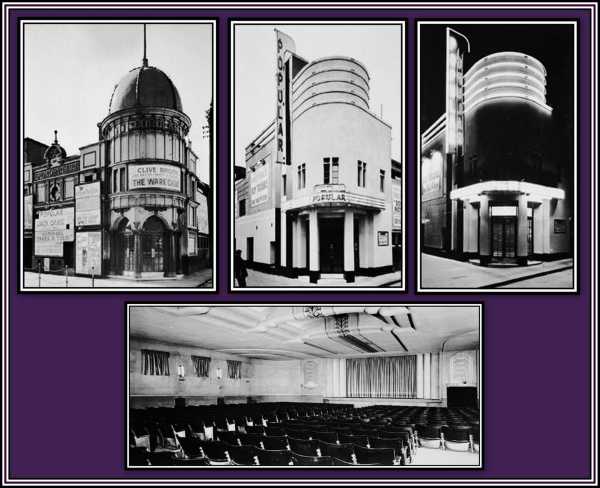 The Popular Cinema, once managed by Mr. Phil Hyams, opened in 1913, was closed in 1959 and demolished in 2008.
The Popular Cinema, once managed by Mr. Phil Hyams, opened in 1913, was closed in 1959 and demolished in 2008.
It was a few yards from the Troxy Super Cinema.
In 1927, the Hyams Brothers purchased a tram shed in Stratford and built here, with George Coles (1884-1963) as architect, what was to be Britain’s first Super Cinema, the Broadway. The auditorium was palatial in its decoration, which became a trademark of the Super Cinemas that they built. Prior to the Broadway‘s official opening, Mr. Hyams displayed his keen sense of showmanship by offering the building to the British Legion for a rally, which was to be attended by the Prince of Wales thereby gaining enormous publicity for the Super Cinema.
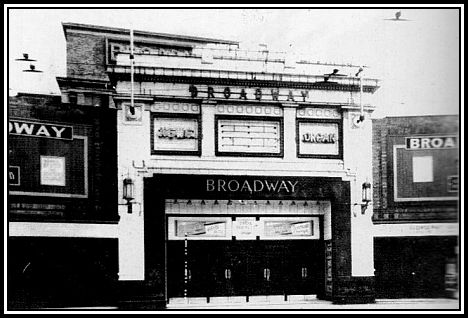 The Broadway Super Cinema Stratford
The Broadway Super Cinema Stratford
Reproduced from Cinema Treasures
The Hyams Brothers quickly sold the Broadway and their cinema circuit in 1928 to Gaumont-British and promptly, together with A.J. Gayle and with George Coles as architect, launched H & G Kinemas.
-oOo-
The Hyams motto was:
If you give ’em value, they will come.
-oOo-
H & G Super Cinemas joined forces with Gaumont-British in 1935 in order to increase the number of films available to them. H & G Kinemas also built other Super Cinemas including the Trocadero Elephant & Castle, opened in 1930, the Troxy Cinema Stepney, opened in 1933, and the State Kilburn, opened as the Gaumont State in 1937. The company had plans to build Super-Cinemas at Holloway and Kingston, but sold these properties before they opened.
H & G Kinemas sold out their cinema holdings to Gaumont in 1944, and in 1947, launched Eros Films, a film distribution company, which sadly went bankrupt in 1961.
-oOo-
Mr. Phil Hyams celebrated his 100th birthday at a reception given for him at the Gaumont State Kilburn in 1994. Mr. Hyams died in 1997.
-oOo-
THE TROCADERO SUPER CINEMA
-oOo-
The Trocadero Theatre was a magnificent Super Cinema once present in the Elephant & Castle area of South London, which was once hailed as The Piccadilly of South London and was an Entertainment Mecca both for local inhabitants and for those from all over London.
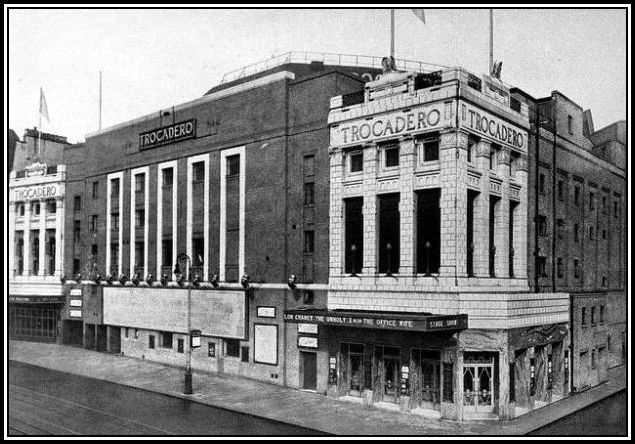 The Trocadero Super Cinema in 1931
The Trocadero Super Cinema in 1931
Awaiting permission from The Cinema Museum to reproduce this photograph
The Trocadero Super Cinema was built in 1930 for H & G Kinemas with George Coles as the architect and had a combined capacity in stalls and circle of ~3400 seats (the actual number available to patrons varies according to the source of reference). The decor was in Renaissance style and with an atmospheric theme. On the side walls were a number of huge drapes and the ceiling had a huge illuminated dome. Without doubt, the auditorium must have been a memorable site to see.
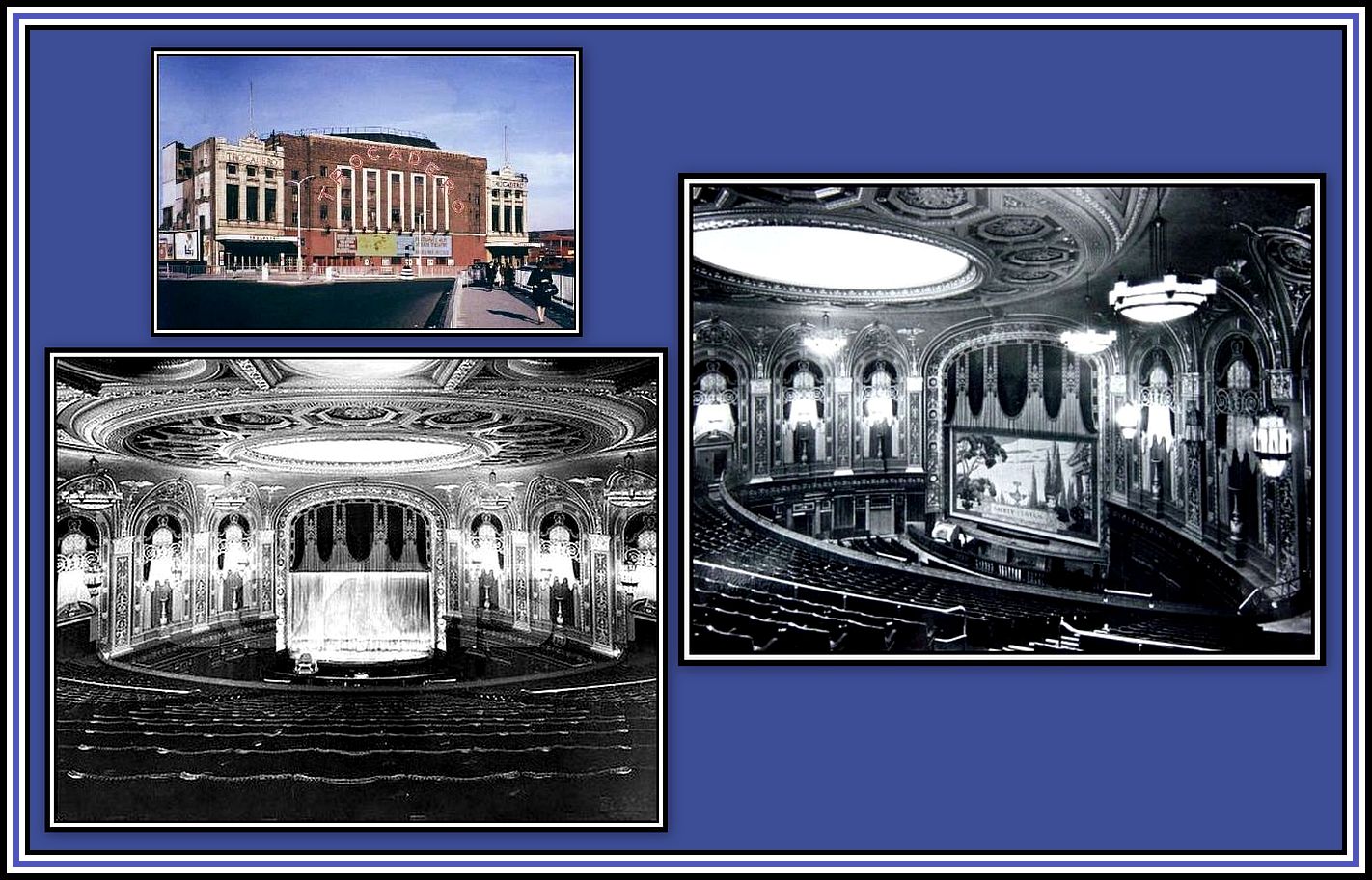 The Trocadero Super Cinema – Exterior View & Auditorium
The Trocadero Super Cinema – Exterior View & Auditorium
showing the Wurlitzer Theatre Organ to the left in the Orchestra Pit
These photographs are reproduced from the website, Drango in the U.K. 1938
-oOo-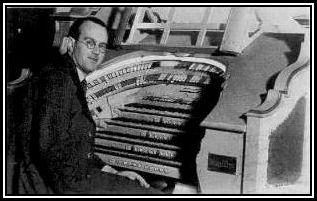 Quentin Maclean at the Trocadero Wurlitzer Theatre Organ
Quentin Maclean at the Trocadero Wurlitzer Theatre Organ
The Trocadero opened in December 1930, and to complement this magnificent Super Cinema, the largest Wurlitzer Theatre Organ to be imported into the U.K. was purchased and installed. The Organ was played by Quentin Maclean (1896-1962) at the opening who was to become, and remain, the resident organist for the following nine years.
Click here to hear Song of Songs
played by Mr. Quentin Maclean at the Torcadero Wurlitzer Theatre Organ
-oOo-
According to my father, a number of elephants were in attendance at the opening! I feel sure that the animals were part of a stage show and not patrons seated in the stalls!
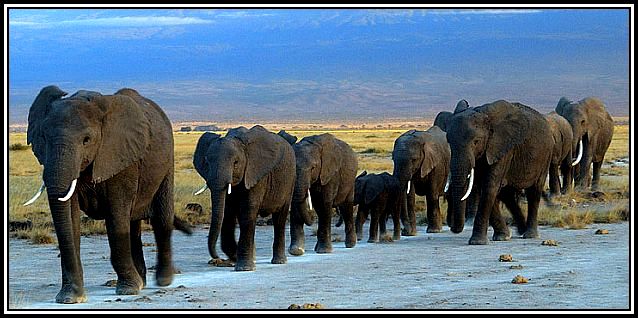
My father loved going to The Troc and saw a number of films and entertainers there. He said that the management always put on a good show for good value. He was both upset and annoyed when it was closed and then demolished. He was even more horrified when the modernisation of the Elephant & Castle area took place.
Unfortunately, I only saw the Trocadero from the outside, but I recall it as being very impressive. I remember the neon lighting, which at that time, had been formed into shapes to simulate orange trees with bright green branches and orange trunks.
-oOo-
Apparently by the 1950s, the Super Cinema had become renowned as a site of violent behaviour by local Teddy Boys.
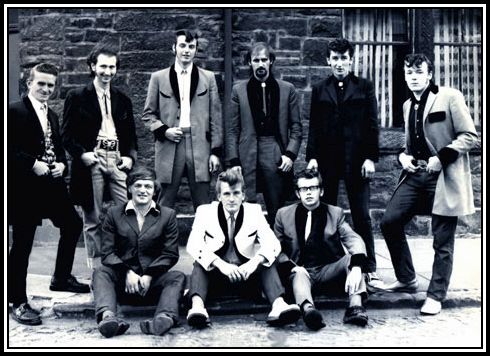
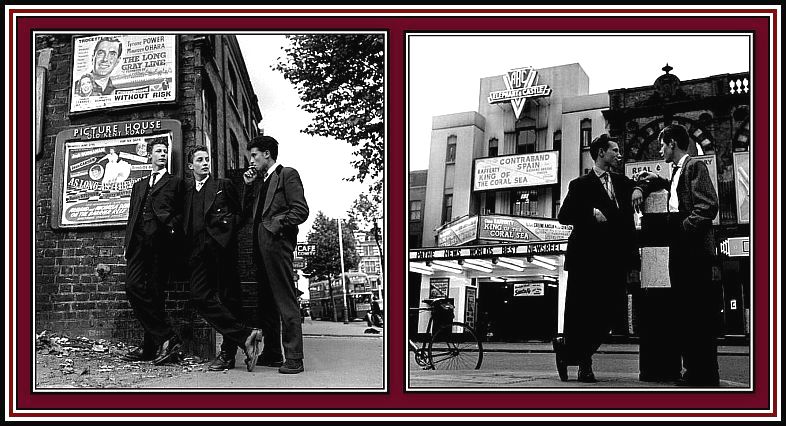 Elephant & Castle Teddy Boys
Elephant & Castle Teddy Boys
Reproduced with permission of The Edwardian Teddy Boy
When the film, Rock around the Clock (1954) was screened there, fights broke out among the patrons and seats were ripped with the knives carried by the Teds. General mayhem broke out in the aisles on one occasion, which resulted in severe injury to two policemen. These activities led to the film being banned in a number of communities in the U.K. for a time afterwards.
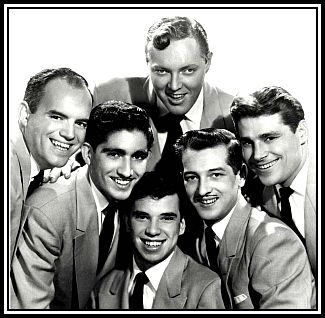 Click here to hear Rock around the Clock by Bill Haley & His Comets
Click here to hear Rock around the Clock by Bill Haley & His Comets
-oOo-
The Trocadero Super Cinema had been built with full stage facilities including dressing rooms and over the years a number of popular performers and stage shows were presented here.
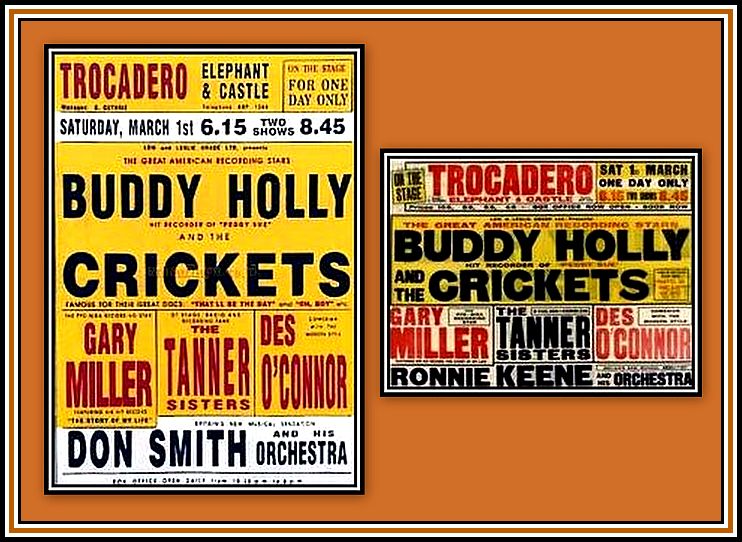
Once Rock ‘n’ Roll Shows were staged at the Trocadero, it is said that the Teds insulted certain performers: coins were seemingly thrown at Cliff Richard (born 1940) and jeers hurled at Bobby Darin (1936-1973). Buddy Holly (1936-1959), in 1958) and Duane Eddy (born 1938) faired better, as they were greatly admired by these patrons. Bobby Darin and Duane Eddy together with Clyde McPhatter (1932-1972) appeared at the Trocadero of the 23rd April, 1960, as part of one of the first U.K. tours of its kind by American artists.
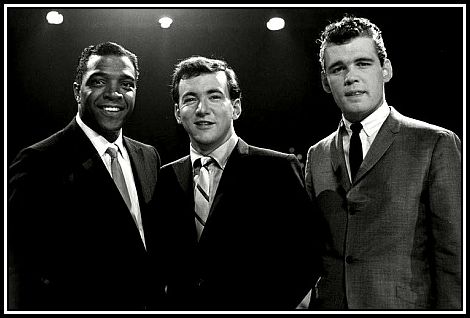 From Left to Right: Clyde McPhatter, Bobby Darin & Duane Eddy, 1960
From Left to Right: Clyde McPhatter, Bobby Darin & Duane Eddy, 1960
Click here to hear Lovey Dovey by Clyde McPhatter
Click here to hear Queen of the Hop by Bobby Darin
Click here to hear Rebel Rouser by Duane Eddy
At this time, Bobby Darin was in transition from being purely a Rock ‘n’ Roll singer to one more suited to Night Clubs. I can only imagine the Teds’ reaction when Mr. Darin began to sing Beyond the Sea and Mack the Knife, although if they had chosen to listen to the lyrics of this song, they might have been more appreciative of the singer!
-oOo-
THE REDEVELOPMENT OF THE ELEPHANT & CASTLE
and
THE DEMISE OF THE TROCADERO SUPER CINEMA
-oOo-
Apparently, by 1960, the Trocadero Super Cinema had fallen into an ill-kept state. Cinema-going had markedly declined by now following the boom during the Post-War Years thanks mainly to the popularity and availability of television. Ticket sales were also down due to the bomb damage done to the area and with the subsequent re-housing of much of the local population to new homes elsewhere.
As a result, as the building’s monetary value decreased, the land value of the area markedly increased. The Elephant & Castle area was seen as Prime Real Estate after the Second World War since its road system offered access to the City and other areas of significance in North and Central London.
Numerous plans were proposed to redevelop the whole of the area and some included proposals to widen the roads that converged here in an attempt to streamline traffic flow and relieve congestion.
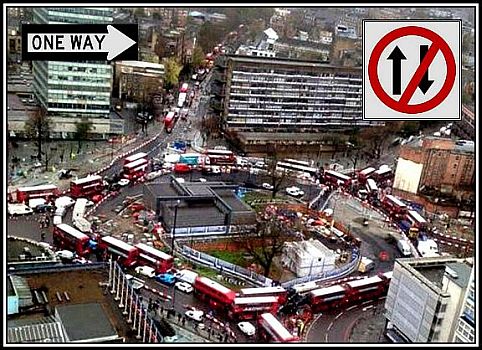 The Elephant & Castle during rush hour, 2014
The Elephant & Castle during rush hour, 2014
The adopted plan for the redevelopment of the Elephant & Castle included the demolition of the Trocadero Super Cinema to make way for some of the proposed changes.
Evidently the then owners of the Trochadero, The Rank Organisation, were not too distressed at this and closed the Super Cinema permanently on the 19th October, 1963. Rank, which at the time, owned the cinemas of both the Odeon and Gaumont Circuits, obviously realised the need to diversify, as they were converting many of these cinemas into Top Rank Bingo Clubs or closing them.
The Trocadero that had once symbolised popular entertainment at its best was soon demolished and an office block, the Alexander Fleming House and a small Odeon Cinema. both designed by Erno Goldfinger (1902-1987), were built on the site. Neither building faired well.
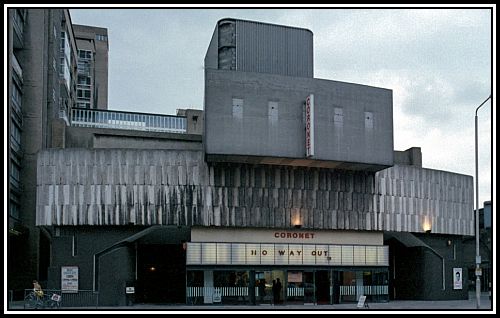 The Erstwhile Odeon Cinema Elephant & Castle, later renamed The Coronet
The Erstwhile Odeon Cinema Elephant & Castle, later renamed The Coronet
The Odeon Cinema opened in December 1966, but was closed in July 1988 and was itself demolished soon after. The site apparently remained vacant until 2008.
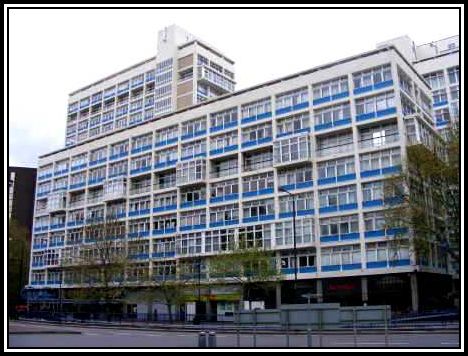 Alexander Fleming House, later renamed Metro Central Heights
Alexander Fleming House, later renamed Metro Central Heights
The Alexander Fleming House was built as an office block and its tenant was the Ministry of Health (The Department of Heath & Social Security, DHSS). The building apparently suffered from Sick Building Syndrome and, once diagnosed, the workers and tenant beat a hasty retreat to pastures new! Following this, in 1998, the building was converted for residential use and renamed Metro Central Heights.
In 2004, plans were drawn up to build a 15-storey addition to the building on the site of the erstwhile Odeon Cinema. Construction was completed in 2008.
In July 2013, English Heritage added Metro Central Heights to its list of Grade II buildings.
-oOo-
THE TROCADERO WURLITZER THEATRE ORGAN
THE LARGEST WURLITZER EXPORTED TO EUROPE
-oOo-
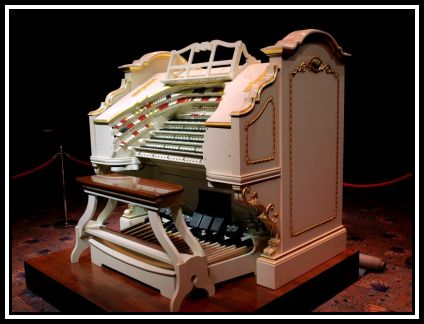 The Trocadero Wurlitzer Theatre Organ Console (now installed at the Troxy Stepney)
The Trocadero Wurlitzer Theatre Organ Console (now installed at the Troxy Stepney)
Click here to have a closer look at the Console
Click here to hear the 1812 Overture
played by Mr. Quentin Maclean at the Torcadero Wurlitzer Theatre Organ
The Trocadero Wurlitzer Organ (Style 270) had 4-Manuals, a Pedal Board, 241 Stop-Keys and 21-Ranks together with over 1,700 Organ Pipes. What was unusual for an Organ of its size was that it only had one Tibia Clausa, which is the Stop on which the Theatre Organ is founded.
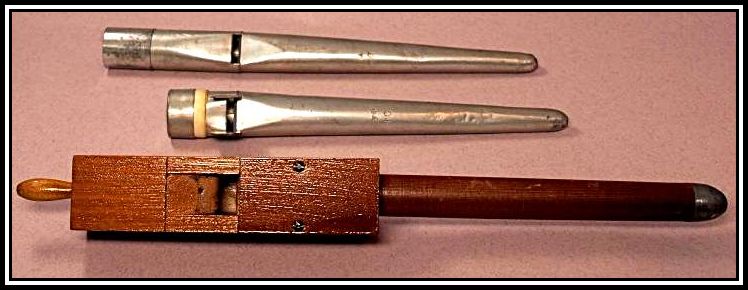 Comparison of different Wurlitzer Tibia Pipes from the same Rank – wooden, capped and open
Comparison of different Wurlitzer Tibia Pipes from the same Rank – wooden, capped and open
Reproduced with permission of The Cinema Organ Society
-oOo-
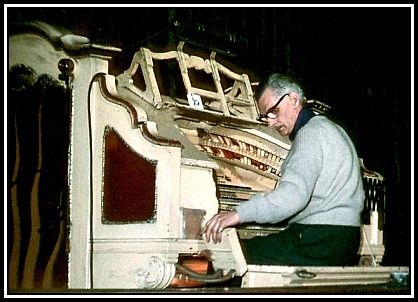 Robin Richmond at the Wurlitzer Organ of the Trocadero
Robin Richmond at the Wurlitzer Organ of the Trocadero
-oOo-
WHAT TO DO WITH
THE TROCADERO WURLITZER THEATRE ORGAN
ONCE THE SUPER CINEMA CLOSES
-oOo-
With the announcement that the Trocadero Super Cinema would close, the Wurlitizer Organ was purchased by The Cinema Organ Society and removed by February 1961. The Organ was eventually installed in Edric Hall, part of South Bank University, in 1979 and it was played by William Davies (1921-2006), who had been the organist at its final performance at the Trocadero.
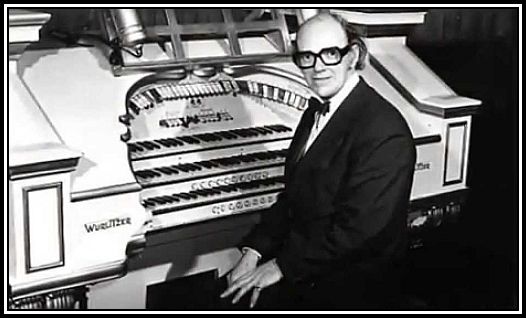 William Davies at the Wurlitzer Organ of the Granada East Ham
William Davies at the Wurlitzer Organ of the Granada East Ham
However in 2003, plans were drawn up to convert Edric Hall into an Arts Centre. The powers-that-be decided that, after 24 years in the Hall, the Organ would no longer fit in with the proposed plans for the Hall. Robert Wolfe played the Organ at the Farewell Concert given in the Hall.
In 2004 the Organ was dismantled and put into storage in an underground car park where it remained while the owners searched for a suitable site for its re-installation.
-oOo-
Click here to learn about the Theatre Organs of The Trocadero & Troxy Super Cinemas
-oOo-
A NEW HOME FOR
THE TROCADERO WURLITZER THEATRE ORGAN
-oOo-
After careful thought and discussion, it was decided that the Troxy Stepney would be the ideal site for the Trocadero Wurlitzer Organ. Seeing that the Troxy was a sister Super Cinema to the Trocadero and built for H & G Kinemas, this would indeed seem to be an excellent choice, and once an agreement was reached, the installation work began in 2010 work began under the direction of The Trocadero Wurlitzer Trust.
-oOo-
THE TROXY STEPNEY
-oOo-
The Troxy Cinema was built for the H & G Kinemas and was designed by George Coles in an opulant Art Deco style and was one of the largest cinemas built in the U.K. with over 3,000 seats. The Cinema had a cafe at the circle level and was fitted with a number of dressing rooms and a revolving stage used during the live shows presented here. The Troxy opened in September 1933 with a showing of King Kong.
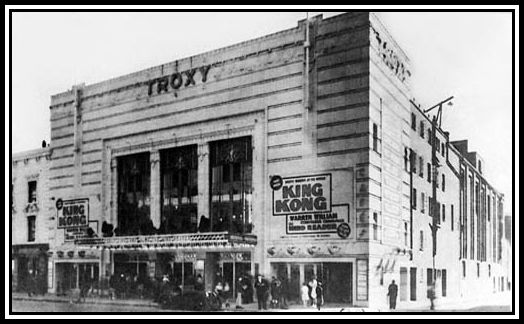
-oOo-
A Wurlitzer Organ with 3 Manuals and 10 Ranks was installed at the Cinema, part of which had been made at Wurlitzer’s London Factory. In 1933, as a way to avoid import tax completely and reduce the price of their organs, The Wurlitzer Company opened a factory Charlton Kings Road in Kentish Town, London N.W.5. Here many of the non-vital parts of their organs were to be built.
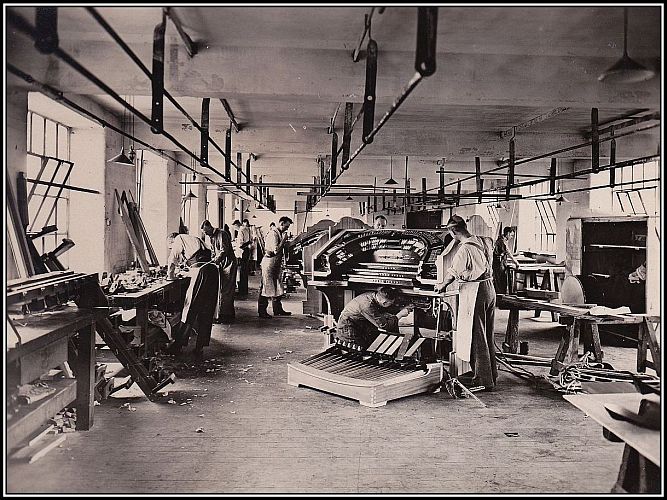 The Wurlitzer Factory in Kentish Town – the Organ in the foreground was destined for installation at the Regal Cinema Edmonton and the one behind for the Troxy Cinema Stepney
The Wurlitzer Factory in Kentish Town – the Organ in the foreground was destined for installation at the Regal Cinema Edmonton and the one behind for the Troxy Cinema Stepney
The Troxy Wurlitzer Organ was played by Bobby Pagan at the Cinema’s opening.
Click here to see and hear Bobby Pagan play the Theatre Organ
-oOo-
The Troxy Cinema was taken over by Gaumont Super Cinemas from August 1935 and in February 1944 came under the full ownership of Gaumont British Theatres.
As the Cinema is in the former Borough of Stepney and close to the London Docks, the area suffered much from bombs during the Second World War. As with the Trocadero Super Cinema, the damage resulted in many people moving elsewhere, resulting in a decline in ticket sales. This, together with the increase sales of television sets, caused The Rank Organisation to close the Cinema in November 1960.
With the closure of the Troxy, the Organ was removed and broken up and various parts were sold. There appears to be no complete record to allow organ enthusiasts to know where these parts are now.
-oOo-
The building remained without usage for three years. However in 1963, the Royal Opera House, Covent Garden took over the building for use as a rehearsal site and continued to do so until 1990.
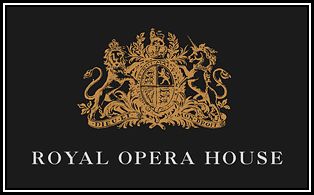
The stage was extended to become the same size at that of Royal Opera House at Covent Garden. The company also made use of the rear stalls area as a workshop where scenery was constructed and the rear circle as a storage space. The necessary changes to the auditorium were undertaken by George Coles et al.
-oOo-
The Troxy Cinema was given a Grade II Listed building status by English Heritage in January 1991 and underwent restoration as a result. The building was reopened to the public, first as a Top Rank Bingo Club and later a Mecca Bingo Hall until 2006 when it once again became empty.
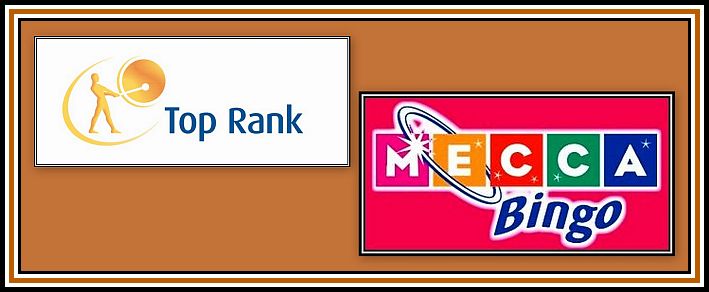
-oOo-
In 2007, the Troxy was restored and became a Banquet Hall. In October 2008, use of the venue was expanded and it began to be used for concerts, conferences and sports events in addition to being a nightclub.
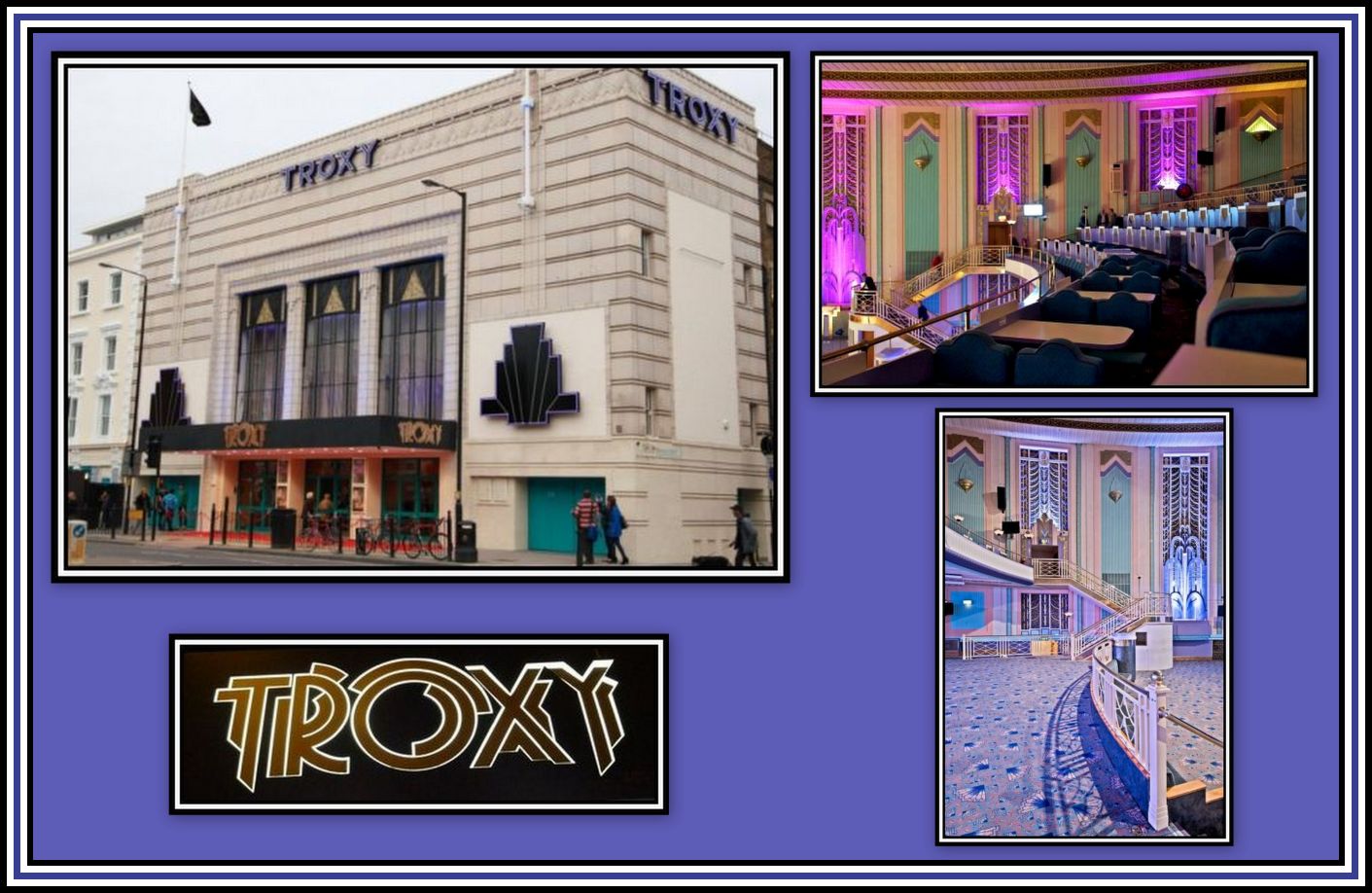 The Troxy Today
The Troxy Today
I was fortunate enough to be given free access to the Troxy Stepney soon after the restoration work was complete. The building has been restored to its former magnificence and elegance and looked spectacular.
-oOo-
A NIGHT OF A THOUSAND PIPES
-oOo-
In December 2009, the Cinema Organ Society announced that agreement had been reached for the former Trocadero Wurlitzer Organ, now with 4 Manuals and 24 Ranks, was to be installed at the Troxy Stepney.
I have it on good authority from the Chairman of The Wurlitzer Organ Trust, Mr. Simon Gledhill, that the Trocadero Wurlitzer Organ had three Ranks added to it while installed at Edric Hall (South Bank University) and these were:
Tibia Clausa (Main chamber)
Oboe Horn (Solo chamber)
Vox Humana (Main Chamber)
The installation process began in 2010 and while this was in progress at the Troxy, a 25th Rank was prepared at added to the Organ and was a Solo String Celeste (Solo chamber).
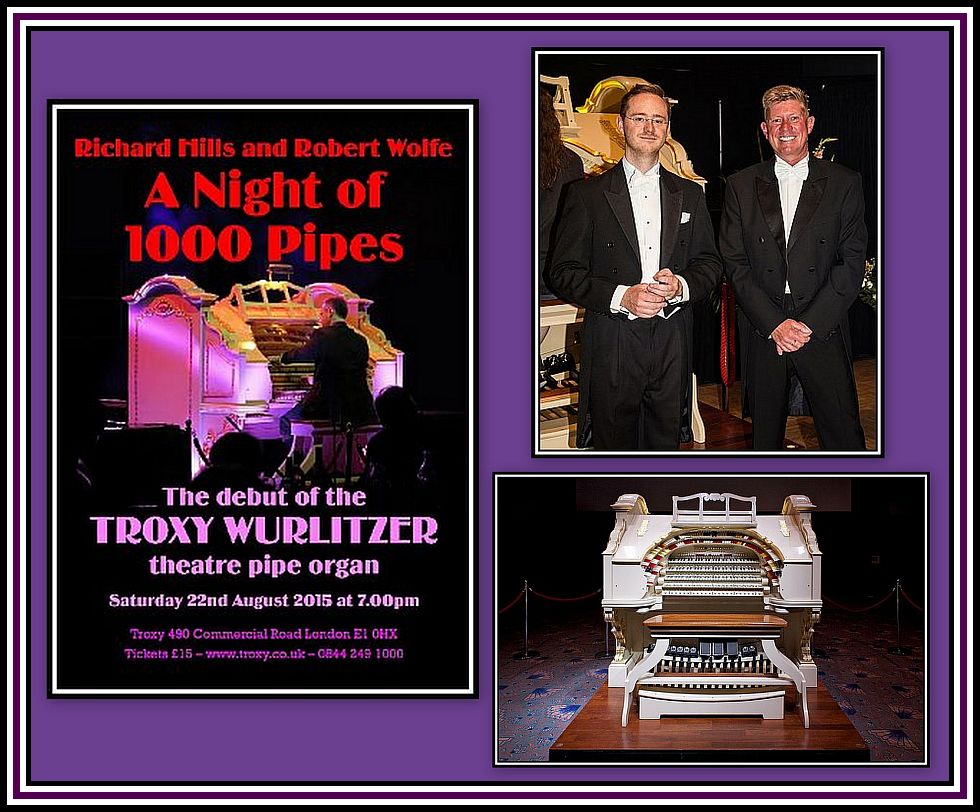 Right: Poster; Top Left: The Organists, Richard Hills & Robert Wolfe;
Right: Poster; Top Left: The Organists, Richard Hills & Robert Wolfe;
Bottom Left: The Trocadero-Troxy Wurlitzer Organ;
Reproduced from the CNTV (English) Website
The first public concert given at the Troxy on the restored instrument, entitled A Night of a Thousand Pipes, took place on 22nd August, 2015 with organists Robert Wolfe and Richard Hills, and was received well by the audience.
-oOo-
Click here to watch a television report on the Trocadero-Troxy Wurlitzer Organ from August 2015
-oOo-
Click here to see the video, The Mighty Wurlitzer at the Troxy
-oOo-
Click here to watch the lecture, From Trocadero to Troxy: A Tradition Returns given at
Gresham College by John Abson & Richard Hills
——-oooOOOooo——-
CLICK HERE
TO READ ABOUT
THE WURLITZER ORGAN OF
THE GRANADA THEATRE TOOTING
OR
CLICK HERE
TO RETURN TO
MY VISIT TO TONAWANDA,
THE HOME OF THE FORMER WURLITZER ORGAN OF THE EMPIRE LEICESTER SQUARE
——-oooOOOooo——-
——oooOOOooo——
——oooOOOooo——
Click here to return to PART ONE:
INTRODUCTION
——oooOOOooo——
Click here to return to the GLOSSARY
——oooOOOooo——
Click here to return to the THE THEATRE ORGAN HOMEPAGE
——oooOOOooo——
Click here to return to the TABLE OF CONTENTS
——oooOOOooo——

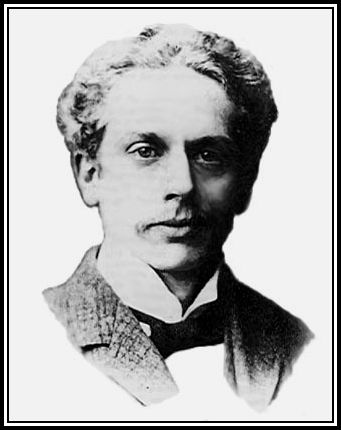
I was in the audience to hear Bobby Darin, Duane Eddy, Clyde McPhatter and Emile Ford on the 23rd April 1960, and your description is absolutely correct! Bobby Darin was booed because the audience thought he was too full of himself. He was making the transition you described. Duane Eddy and Clyde McPhatter were hits and so was the warm-up act of Emile Ford. At the time I was living in Higher Denham and working on Berners Street at the big, new Sanderson showroom (now a hotel.) The Teds of that day were more hype by the tabloids than reality and life in London was hardly swinging or about to swing. That was also a hyped-up story by the tabloids, and even the screaming girls in New York greeting the Beatles had been coached to scream and paid shills were planted to among them – just like the Billy Graham religious crusades. They were ‘ancient’ times – I bought my first Little Richard record on a 78rpm! What many claim happened back then and what really happened are two different stories, but I still love Duane Eddy’s ‘Rebel Rouser’ – it is one of those records that you ‘know’ when you hear that first note!
Mervyn: Many thanks for sending your interesting comment. With truly great pieces of music, all you need is one note!!! ‘Rebel Rouser’ is one such tune! Regards. Charles